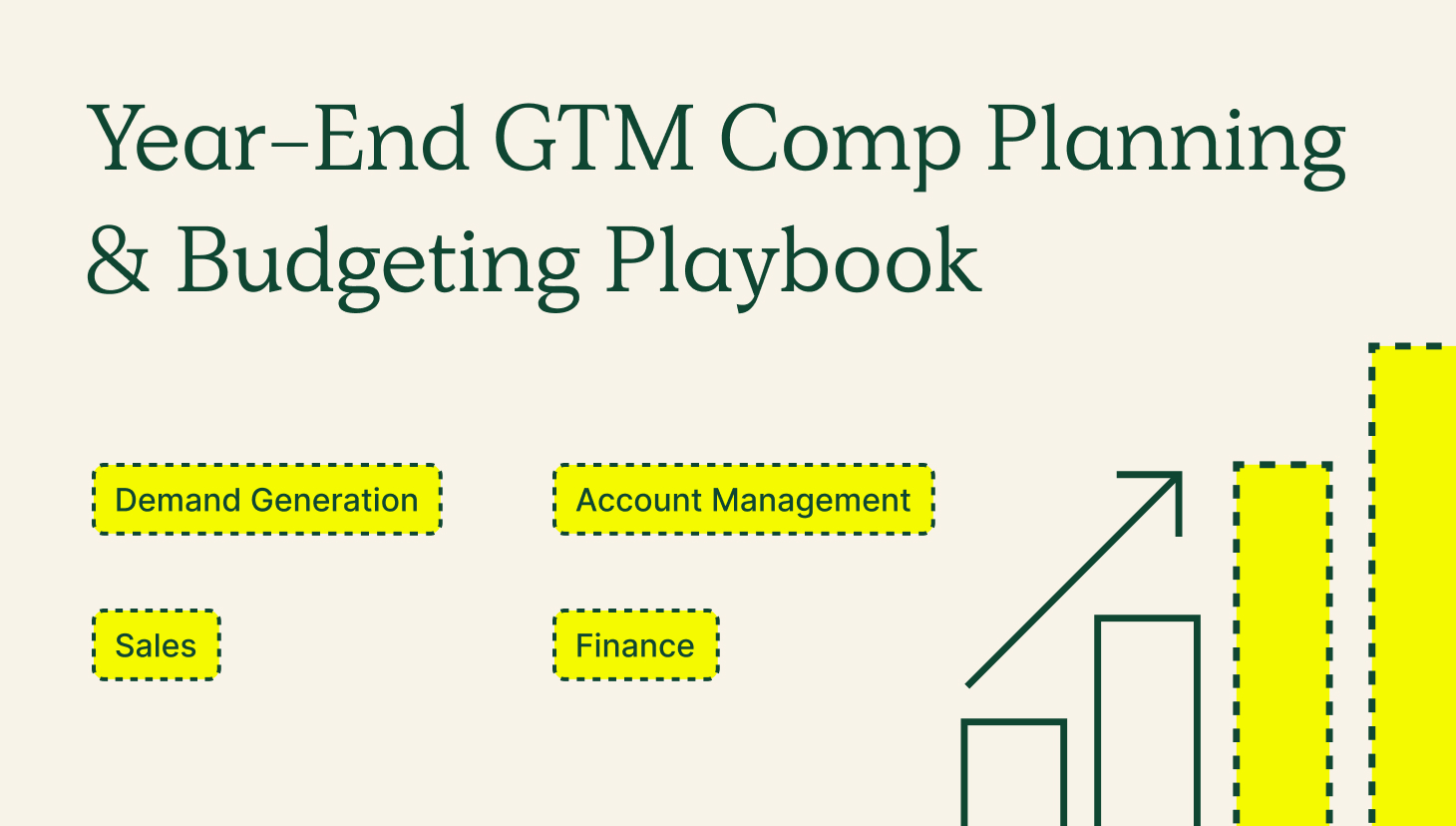Aligning your compensation plans with broader company goals is not just a best practice but a necessity.
A recent survey of nearly 500 revenue leaders found that 25% identified “alignment to business goals” as the top area needing improvement in their sales compensation management process.
This highlights a critical issue: compensation plans can miss the mark without alignment, driving short-term wins at the cost of long-term success.
That’s why it’s important to create your compensation plans in conjunction with your team’s go-to-market (GTM) strategy as your budgeting for the following year.
GTM-strategy-aligned compensation plans can directly influence key metrics such as pipeline growth, customer retention, and average contract value, all of which are vital for achieving sustainable revenue growth.
Below are some ways to think about driving your GTM strategy via your compensation plan.
How to Build a Go-to-Market Strategy
Whether you are launching a product or entering a new market, you need a go-to-market (GTM) strategy to help you achieve your goals.
Read MoreStart By Identifying Your Most Important Metric
Under no circumstances should your comp plan creation proceed by identifying the biggest driver of your business.
Instead, start with the business objective.
Then, create ways to incentivize all branches of your GTM team to drive them.
A successful GTM strategy is built on clearly defined business objectives, such as increasing average deal size and boosting customer lifetime value.
However, these objectives are only meaningful if your teams are motivated to achieve them.
This is where compensation planning plays a role.
By structuring comp plans directly tied to your GTM goals, you can influence the behaviors that matter most. This ensures that every deal closed, lead generated, and customer retained contributes to your overarching business objectives.
Key GTM Metrics
So, which metrics should you be thinking about?
Below is an overview of the core GTM metrics you should consider when structuring your comp plans:
Demand Generation
- Marketing Qualified Leads (MQLs): MQLs represent the leads most likely to convert into sales. Incentivizing demand generation teams or business development reps (BDRs) based on the number of MQLs generated encourages a steady pipeline of high-quality leads for the sales team.
- Pipeline: A healthy sales pipeline is critical to future revenue. Compensation plans can include bonuses or rewards tied to pipeline growth, ensuring that teams focus on building a sustainable flow of opportunities that can be converted into closed deals.
- Average Contract Value (ACV): ACV measures the average revenue per customer contract. Deals with higher ACV tend to bring more value to the business, and by offering higher commission rates or bonuses for deals that exceed a certain threshold, you can encourage your team to pursue larger opportunities.
Sales
- Qualified Pipeline: Focusing on the qualified pipeline ensures that reps aren’t just filling the funnel with leads but actively engaging prospects more likely to convert. Compensation plans can be structured to reward reps based on the number or value of qualified opportunities they generate.
- Win Rates: Improving win rates—the percentage of deals closed versus deals in the pipeline—directly reflects a sales team’s effectiveness. Tying comp plans to increase win rates motivates reps to focus on closing quality deals and refining their sales approach.
- ACV: Similar to demand generation, incentivizing sales teams based on ACV ensures that reps target larger, more profitable accounts, ultimately contributing to higher revenue growth.
Account Management
- Gross Revenue Retention (GRR): GRR measures the percentage of revenue retained from existing customers before considering upsells or expansions. Compensation plans that reward account managers for maintaining or increasing GRR encourage them to build long-term relationships and reduce churn.
- Net Revenue Retention (NRR): NRR takes into account upsells, expansions, and cross-sells and reflects the total revenue retained from existing customers. Aligning incentives with NRR helps drive a focus on both retaining customers and expanding their accounts over time.
- Product Adoption: For SaaS businesses, encouraging customer adoption of new products or features can drive long-term value. Account managers can be rewarded based on product adoption milestones, ensuring that customers fully utilize the solutions, leading to higher satisfaction and retention rates.
Finance
- Lifetime Value (LTV): LTV measures the total value a customer brings over their entire relationship with the company. By linking commissions to LTV growth, sales, and account management teams are encouraged to focus on closing deals and nurturing long-term, high-value relationships.
- Burn Rate: This metric tracks the rate at which a company spends capital. Keeping the burn rate within acceptable limits is crucial, especially for startups and growth-stage businesses. Compensation plans can include financial performance incentives, helping align all teams with the company’s budgetary goals.
- Customer Acquisition Cost (CAC): CAC measures the cost of acquiring new customers and is a critical factor for growth and profitability. Compensation models that reward reps for keeping acquisition costs low (while still closing quality deals) help drive more efficient sales processes.
How to Solve For CAC, LTV, and Gross Margin Using Sales Comp
Build efficiency by aligning your sales compensation strategy with up-funnel metrics so that your entire go-to-market team focuses their efforts on the most important areas of your business.
Read MoreIdentifying the Key Metric to Improve
Now that you know which metrics to look at, it’s time to identify the metric.
Choose this based on the one most directly tied to your financial plans and strategic goals. You could start by asking: which metric will make or break our revenue plan?
Example: Increasing Average Contract Value (ACV)
If your goal is to break into the enterprise market, increasing the average contract value (ACV) should be a top priority. This focus will influence how you design compensation plans, from higher commission rates for larger deals to bonuses for enterprise-level customers.
By focusing on the most critical metric, you can ensure that your compensation plan motivates sales reps and supports the company’s long-term growth goals.
In the past, many teams have relied on traditional methods to improve metrics like ACV or win rates, such as:
- Attending Enterprise Events
- Account-Based Marketing (ABM)
- Hiring Specialized Talent
While these approaches have proven effective in driving progress, they often fall short without a well-aligned compensation plan.
Compensation plans should be structured to support these efforts, ensuring reps are consistently incentivized to pursue and close larger, more complex deals.
But, it would be best if you first recognized the challenges that hold back your key metric.
One of the main reasons enterprise deals are harder to close than small-to-medium business (SMB) deals is the complexity and length of the sales cycle. Enterprise sales often involve multiple stakeholders, longer decision-making processes, and more complex contract negotiations. Additionally, enterprise customers typically demand more customized solutions, further adding to the challenge.
It’s often easier for reps to close multiple smaller SMB deals in the same time it takes to close one enterprise deal. However, the payoff from larger deals is usually significantly higher.
Compensation plans should provide substantial incentives to motivate sales reps to focus on these larger opportunities. For example, offering a higher commission rate or bonuses for deals that exceed a certain value threshold can encourage reps to invest the time and effort required to close enterprise accounts.
Compensation Levers:
- Account Executives: Higher commission rates for deals over a certain value.
- Business Development Reps (BDRs): Bonuses for demos or opportunities created with large deals.
- Account Managers: Bonuses for expanding accounts over a threshold value.
Understanding your metric’s opportunities and challenges and structuring compensation plans accordingly can drive meaningful improvements in your GTM performance.
Add Organizational-wide Incentives
Another tip: Don’t stop at your immediate GTM teams.
Consider adding incentives for every department that could drive change.
If we continue on our example from above, you could look into the following:
- Marketing: Bonuses for generating enterprise pipeline.
- Product & Engineering: Bonuses for delivering enterprise-grade features.
- Customer Experience (CX): Rewards for driving enterprise customer adoption.
Measuring the Success of Your Comp Plan
Once your compensation plans are in place, tracking its success to ensure that it’s driving the desired outcomes.
To measure the effectiveness of your comp plan, focus on up-funnel metrics—the early indicators that show whether your strategy is moving in the right direction. These metrics provide valuable insights long before your end-of-year results are finalized, allowing you to adjust and optimize real-time performance.
Tracking Up-Funnel Metrics
Up-funnel metrics offer an early view into how well your compensation plan influences behavior. By identifying early signals of success, you can course-correct if needed and ensure your team is on track to meet your key GTM objectives. When you tie compensation plans to specific GTM goals, it’s important to track indicators that signal improvements before larger results, like revenue or retention, become apparent.
Key Up-Funnel Metrics for Predicting Success
To evaluate the success of your compensation plan in driving improvements in areas like ACV or customer retention, consider monitoring the following up-funnel metrics:
- % of enterprise customers adopting the product in the first 90 days: This metric indicates how quickly new enterprise customers are seeing value from your product, which strongly predicts long-term retention and revenue expansion.
- Average selling price (ASP) of new customers: Tracking the ASP of new deals can help you assess whether your comp plan motivates reps to close larger, more profitable deals, directly impacting ACV.
- % of pipeline from enterprise customers: By monitoring how much of your pipeline consists of high-value enterprise opportunities, you can gauge whether your sales team is focusing on the right accounts, as incentivized by your comp plan.
- Enterprise product usage rates: High customer usage rates are a leading indicator of future upsells, expansions, and renewals. Tying part of your compensation plan to product adoption can help ensure account managers are driving this key metric.
Iterating on Your Plan
Lastly, compensation plans should not be static.
Tracking these up-funnel metrics and regularly analyzing their trends can refine your comp plans to better align with company goals and evolving market conditions.
If specific metrics aren’t showing the expected progress, consider adjusting incentives or shifting focus to other key areas. This iterative process helps ensure that your compensation plan remains a powerful tool for driving the right behaviors and delivering on your GTM strategy.
Key Takeaways for 2025 Planning
As you prepare for 2025, here are the key takeaways for building compensation plans that align with and enhance your GTM strategy:
- Expand Incentive Programs Across the Company: Compensation plans shouldn’t just be the sales department’s responsibility. Aligning incentives across teams like marketing, customer success, and finance ensures that every part of the organization works toward the same key business goals.
- Drive the Right Metrics: Focus on the metrics that will have the most significant impact on your GTM strategy. Whether it’s increasing ACV, boosting pipeline growth, or improving customer retention, make sure your comp plan is structured to drive these specific outcomes.
- Measure Early and Often: Continuously track up-funnel metrics to ensure your compensation plan works as intended. Regular measurement and iteration help keep your team aligned with company objectives and responsive to changing market conditions.
Streamline commissions for your RevOps, Finance, and Sales teams
Design, track, and manage variable incentives with QuotaPath. Give your RevOps, finance, and sales teams transparency into sales compensation.
Talk to SalesWant more help?
Connect with our team to learn compensation planning best practices and how QuotaPath can help you run and manage sales compensation more efficiently and strategically.



